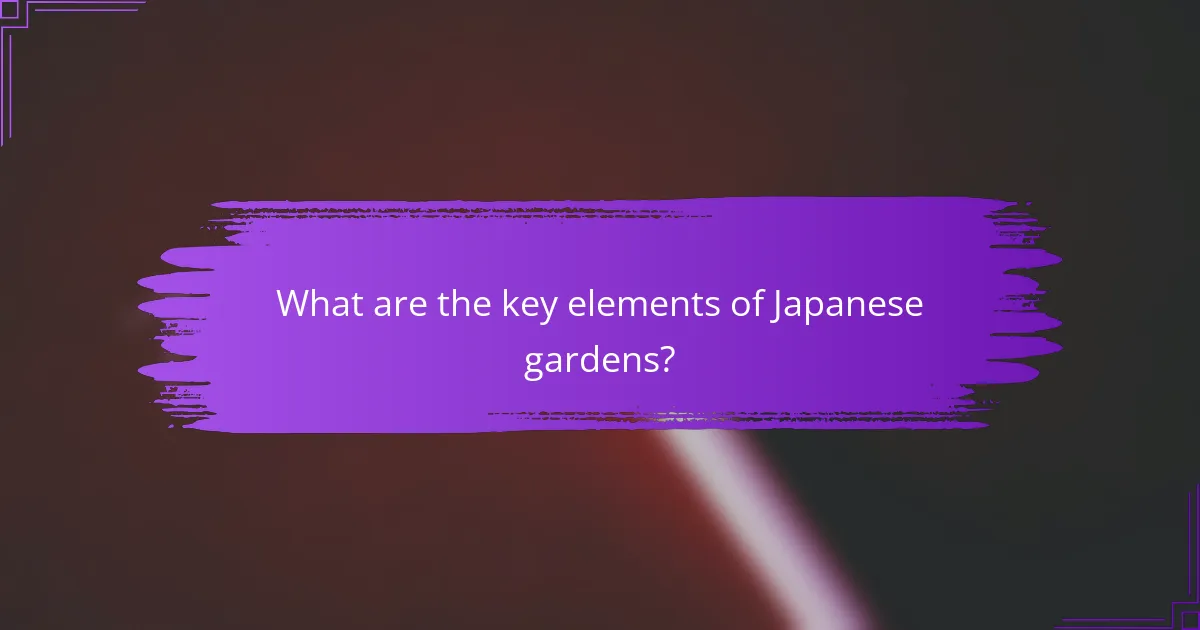
What are the key elements of Japanese gardens?
The key elements of Japanese gardens include rocks, water, plants, and pathways. Rocks symbolize permanence and stability. They are often arranged to represent mountains or islands. Water features, such as ponds or streams, symbolize purity and provide a reflective surface. Plants are carefully selected for their seasonal beauty, including trees, shrubs, and moss. Pathways guide visitors through the garden, encouraging contemplation. Each element is designed to create harmony and balance, reflecting nature’s beauty. Japanese gardens often incorporate Zen principles, promoting tranquility and mindfulness.
How do design principles influence Japanese garden aesthetics?
Design principles significantly influence Japanese garden aesthetics by promoting harmony, balance, and natural beauty. These principles emphasize asymmetry, which creates a more organic feel. Elements such as rocks, water, and plants are arranged to reflect natural landscapes. The use of negative space enhances visual interest and tranquility. Principles also guide the selection of materials that resonate with nature. Traditional concepts like “shakkei,” or borrowed scenery, integrate the surrounding landscape into the garden. Additionally, seasonal changes are considered, allowing gardens to evolve throughout the year. This adherence to design principles results in gardens that are not only visually appealing but also spiritually enriching.
What are the fundamental design principles of Japanese gardens?
The fundamental design principles of Japanese gardens include simplicity, naturalness, and asymmetry. Simplicity emphasizes minimalism and the use of few elements. Naturalness focuses on creating a landscape that reflects nature’s beauty. Asymmetry is crucial, as it avoids uniformity and promotes a more organic look.
These principles aim to evoke tranquility and harmony. They often incorporate elements such as water, stones, and plants. The arrangement of these components is intentional and thoughtful. For example, water features symbolize purity and tranquility. The use of rocks represents mountains and stability. Plants are selected for their seasonal beauty, contributing to the garden’s overall aesthetic throughout the year.
Historical texts, such as “The Book of Tea” by Okakura Kakuzō, highlight these principles in traditional Japanese garden design. The principles have also been influenced by Zen Buddhism, emphasizing meditation and reflection. The success of these gardens can be attributed to their ability to create a serene environment that encourages contemplation.
How do these principles reflect cultural values?
Japanese garden principles reflect cultural values through their emphasis on harmony, nature, and tranquility. These gardens embody the Japanese aesthetic of ‘wabi-sabi’, which appreciates beauty in imperfection and transience. The use of natural materials symbolizes a deep respect for the environment. Elements like water, stones, and plants represent purity and renewal, aligning with Shinto beliefs. The layout encourages mindfulness and contemplation, fostering a connection to nature. Additionally, the incorporation of seasonal changes highlights the importance of time and cycles in Japanese culture. These principles collectively illustrate the cultural values of simplicity, balance, and respect for nature.
What symbolism is present in Japanese garden design?
Japanese garden design symbolizes harmony, tranquility, and the beauty of nature. The layout often reflects natural landscapes, incorporating elements like water, rocks, and plants. Water symbolizes purity and renewal, while stones represent permanence and the earth. Plants, particularly cherry blossoms and pines, embody the transient nature of life and resilience. Bridges in gardens symbolize the journey between different realms, often between the physical and spiritual. Lanterns serve as guides, illuminating paths and creating a sense of safety. Overall, Japanese gardens aim to evoke a serene atmosphere, encouraging reflection and meditation.
How do plants and materials convey meaning in Japanese gardens?
Plants and materials in Japanese gardens convey meaning through symbolism and intentional design. Each plant species is chosen for its cultural significance. For example, cherry blossoms represent the transient nature of life. Bamboo symbolizes resilience and flexibility. Materials like stone and gravel represent mountains and water, creating a miniature landscape. The arrangement of these elements reflects harmony and balance. This design philosophy is rooted in Zen principles, emphasizing tranquility and mindfulness. Historical texts, such as “The Book of Tea” by Okakura Kakuzō, highlight these meanings. Thus, plants and materials serve as a language expressing deeper philosophical concepts in Japanese gardens.
What roles do water features and stones play in symbolism?
Water features symbolize purity and tranquility in Japanese gardens. They represent the flow of life and the passage of time. Stones, on the other hand, symbolize strength and permanence. They often serve as focal points and represent mountains or islands. Together, water and stones create balance and harmony within the garden’s design. This interplay reflects the natural world and philosophical concepts in Japanese culture. Historical texts highlight the importance of these elements in traditional garden design. For example, the Sakuteiki, a 15th-century treatise, outlines their symbolic roles.

What maintenance practices are essential for Japanese gardens?
Essential maintenance practices for Japanese gardens include regular pruning, raking gravel, and managing water features. Pruning shapes plants and encourages healthy growth. Raking gravel maintains the aesthetic and symbolizes calmness. Water features require cleaning to ensure clarity and promote aquatic life. Seasonal plant care includes replacing dead plants and seasonal blooms. Mulching helps retain soil moisture and suppress weeds. Fertilizing supports plant health and enhances growth. Regular inspections for pests and diseases are crucial for garden longevity. These practices ensure the garden remains serene and visually appealing.
How can one effectively maintain a Japanese garden?
To effectively maintain a Japanese garden, regular care and attention are essential. Begin by ensuring proper pruning of trees and shrubs to promote healthy growth. Watering should be consistent, using a method that mimics natural rainfall. Mulching helps retain moisture and suppress weeds. Additionally, seasonal cleaning of pathways and removing debris keeps the garden visually appealing. Fertilization with organic materials supports plant health. Regularly inspect for pests or diseases to address issues promptly. Lastly, maintaining the balance of elements like rocks, water, and plants is crucial to uphold the garden’s aesthetic harmony.
What seasonal tasks are involved in garden maintenance?
Seasonal tasks involved in garden maintenance include planting, pruning, and weeding. In spring, gardeners typically plant new flowers and vegetables. They also prune shrubs to encourage new growth. Summer maintenance often involves regular watering and weeding to keep plants healthy. In fall, gardeners prepare for winter by mulching and cutting back perennials. Winter tasks may include protecting plants from frost. These seasonal tasks ensure the garden thrives throughout the year.
How does maintenance enhance the garden’s symbolism?
Maintenance enhances the garden’s symbolism by representing care and attention to detail. In Japanese gardens, regular upkeep signifies respect for nature. Pruning, weeding, and raking create harmony and balance. This meticulous care reflects the philosophical principles of simplicity and tranquility. The act of maintenance transforms the garden into a living artwork. It embodies the concept of impermanence, emphasizing the beauty in change. Historical practices show that well-maintained gardens are seen as a reflection of the gardener’s inner state. Thus, maintenance deepens the symbolic meaning of the garden in Japanese culture.
What challenges do gardeners face in maintaining Japanese gardens?
Gardeners face several challenges in maintaining Japanese gardens. The intricate design elements require meticulous upkeep. Maintaining the aesthetic balance of stones, water, and plants is essential. Seasonal changes can affect plant health and appearance. Invasive species may disrupt the intended harmony of the garden. Soil quality must be monitored to support specific plant types. Water management is crucial for maintaining ponds and streams. Additionally, pruning techniques must be precise to preserve the garden’s form. Finally, cultural practices and traditional methods require ongoing education for effective maintenance.
How can one address common issues in Japanese garden upkeep?
To address common issues in Japanese garden upkeep, regular maintenance is essential. This includes pruning plants to maintain their shape and health. Weeding should be done frequently to prevent overgrowth. Proper watering techniques are crucial, as Japanese gardens often emphasize natural water features. Mulching helps retain soil moisture and suppress weeds. Seasonal care is necessary, with specific tasks for spring and autumn. For instance, raking gravel or sand patterns is a common practice. Pest management should be organic to preserve the garden’s aesthetics. Soil health must be monitored to ensure optimal plant growth. These practices align with the traditional principles of Japanese garden design, promoting harmony and balance.

What are the benefits of incorporating Japanese gardens into landscapes?
Incorporating Japanese gardens into landscapes provides numerous benefits. These gardens promote tranquility and relaxation through their serene design. They often feature elements like water, stones, and plants that create a peaceful environment. Japanese gardens can enhance property value, making them appealing for real estate. They also encourage biodiversity by providing habitats for various species. The design principles of Japanese gardens foster mindfulness and connection with nature. Studies show that exposure to such environments can reduce stress and improve mental well-being. Additionally, they can serve as educational tools, teaching visitors about Japanese culture and horticultural practices.
How do Japanese gardens contribute to environmental health?
Japanese gardens contribute to environmental health by promoting biodiversity and improving air quality. These gardens often incorporate native plants that support local wildlife, including birds and pollinators. The diverse plant life in Japanese gardens aids in soil conservation and reduces erosion. Additionally, water features in these gardens help regulate local temperatures and create microclimates. The design of Japanese gardens encourages sustainable practices, such as rainwater harvesting. Studies show that green spaces like these can reduce urban heat islands by up to 5 degrees Fahrenheit. Overall, Japanese gardens play a significant role in enhancing urban ecosystems and promoting environmental sustainability.
What ecological advantages do Japanese gardens offer?
Japanese gardens provide significant ecological advantages. They promote biodiversity by creating habitats for various species. The diverse plant selection supports pollinators like bees and butterflies. Japanese gardens utilize water features, enhancing local ecosystems. The design encourages natural water drainage, reducing erosion. Soil quality improves through organic gardening practices. These gardens also contribute to air purification by absorbing pollutants. Lastly, they offer a serene environment that fosters mental well-being, encouraging community engagement with nature.
How do they promote biodiversity in urban settings?
Japanese gardens promote biodiversity in urban settings by creating habitats for various species. They incorporate native plants that attract local wildlife. These gardens often include water features, which support aquatic life. Additionally, they provide shelter and food sources for birds and insects. The diversity of plant life fosters a balanced ecosystem. Studies show that urban green spaces enhance species richness. Japanese gardens also encourage sustainable practices, such as organic gardening. This approach reduces chemical use and benefits the surrounding environment.
What tips can enhance the experience of creating a Japanese garden?
To enhance the experience of creating a Japanese garden, focus on simplicity and natural elements. Incorporate rocks, water features, and plants that reflect the local environment. Use asymmetry to create a more organic feel. Pay attention to seasonal changes, selecting plants that bloom at different times. Incorporate pathways to guide visitors through the space. Use lanterns and bridges to add traditional elements. Maintain a balance between open spaces and dense plantings. Regularly prune and care for plants to ensure a tidy appearance.
The main entity of this article is Japanese gardens, which are characterized by their design principles, symbolism, and maintenance practices. The article outlines key elements such as rocks, water, plants, and pathways, emphasizing their roles in creating harmony and tranquility. It discusses fundamental design principles like simplicity and asymmetry, reflecting cultural values and aesthetics. Additionally, the article addresses the significance of maintenance in preserving the garden’s symbolism and the ecological benefits these gardens offer, including promoting biodiversity and enhancing environmental health. Overall, it provides a comprehensive overview of the importance and intricacies of Japanese garden design and upkeep.